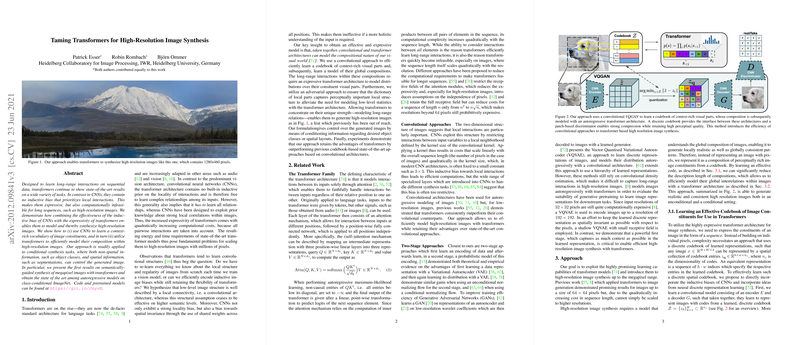Summary of "Taming Transformers for High-Resolution Image Synthesis"
The paper "Taming Transformers for High-Resolution Image Synthesis" presents a novel approach to applying transformer models to high-resolution image synthesis tasks. By leveraging the strengths of convolutional neural networks (CNNs) and transformers, the authors introduce a robust method capable of generating detailed, high-quality images. This method extends previous transformer-based models, which were limited to low-resolution images, to synthesize images in the megapixel range.
Key Contributions
The paper's primary contributions are two-fold:
- VQGAN (Vector Quantized Generative Adversarial Network): To address the inefficiency of transformers in handling high-resolution images due to their quadratic complexity, the authors propose using a CNN-based vector quantizer to create compact, discrete image representations. This model, called VQGAN, employs adversarial and perceptual losses to produce high-quality, perceptually rich codes that encode local image contexts effectively.
- Latent Transformers: With the discrete codebook generated by VQGAN, the authors employ transformers to model global relationships within these codes. This approach allows the efficient handling of high-dimensional data by reducing the sequence length, facilitating high-resolution image synthesis.
Experimental Evaluation
The evaluation of the proposed method across various tasks illustrates its versatility and effectiveness:
- Class-Conditional Image Synthesis on ImageNet: The model achieves competitive FID (Fréchet Inception Distance) and IS (Inception Score) metrics, outperforming previous state-of-the-art models such as VQVAE-2 and BigGAN in certain configurations. The paper highlights these metrics' sensitivity to the rejection sampling process, indicating the fine-tuning strategy used to maximize sampling quality.
- Semantic Image Synthesis: The authors demonstrate the application of their method to conditional synthesis tasks such as generating images based on semantic layouts from datasets like ADE20K and COCO-Stuff. The results show significant improvements over other methods like SPADE, as evidenced here by quantitative FID scores and qualitative comparisons.
- High-Resolution Image Generation: Leveraging a sliding attention window mechanism, the VQGAN-transfoomer model can synthesize images with resolutions surpassing traditional constraints. This capability is tested on datasets such as LSUN Churches and Towers, showcasing that the model maintains both global coherence and local detail at high resolutions.
Implications and Future Directions
The paper's findings suggest several practical and theoretical implications for the field of image synthesis and beyond:
- Scalability and Efficiency: By effectively combining the local efficiency of CNNs with the global modeling capacity of transformers, the method provides a scalable solution for high-resolution image synthesis, a critical step forward from prior models restricted by computational constraints.
- Generalization to Various Image Synthesis Tasks: The unified approach supports multiple forms of conditional image synthesis, including tasks that involve semantic layouts, depth maps, edge information, and more. This generality hints at the broad applicability of the framework across different domains and tasks.
- Potential for Improved Perception Models: The use of perceptually rich codebooks underscores the importance of perceptual quality in generated images, which could influence the development of future models targeting perceptual metrics more directly. The adaptive combination of adversarial and reconstruction losses positions VQGAN as a promising tool for other areas requiring high-fidelity reconstructions.
- Broader Use of Transformers in Vision Tasks: The demonstrated success of transformers in handling high-resolution and structured data may motivate further exploration in other vision-related tasks, such as video synthesis and 3D modeling.
Conclusion
"Taming Transformers for High-Resolution Image Synthesis" successfully addresses the limitation of previous transformer models in terms of resolution and efficiency by incorporating convolutional inductive biases and leveraging the expressivity of transformers. The VQGAN model, combined with transformers, forms a comprehensive framework capable of handling various image synthesis tasks, pushing the boundaries of what transformers can achieve in the field of computer vision. Future work may expand on these findings, exploring further optimization and integration into other vision applications, to continually advance high-resolution image synthesis technologies.
